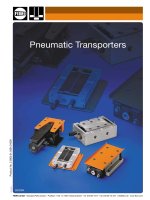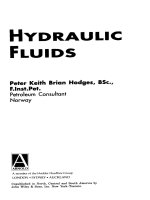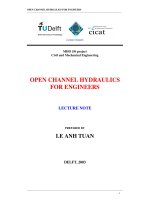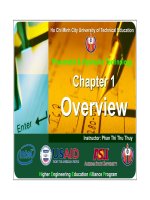Pneumatic & hydraulic hight tech SPKT
Bạn đang xem bản rút gọn của tài liệu. Xem và tải ngay bản đầy đủ của tài liệu tại đây (48.44 MB, 619 trang )
8/28/2013
1
Chapter 1
Overview
Pneumatic & Hydraulic Technology
Ho Chi Minh City University of Technical Education
Overview
Instructor: Phan Thi Thu Thuy
Higher Engineering Education Alliance Program
Chapter 2:
Air Generation
Chapter 2:
Air Generation
Pneumatic & Hydraulic Technology
Ho Chi Minh City University of Technical EducationHo Chi Minh City University of Technical Education
Air Generation
and Distribution
Air Generation
and Distribution
Instructor: Phan Thi Thu Thuy
Higher Engineering Education Alliance Program
Contents
Air compressorAir compressor
1
Air dryersAir dryers
2
Air receiverAir receiver
3
2
Air receiverAir receiver
3
Air distributionAir distribution
4
Air service equipmentAir service equipment
5
www.hcmute.edu.vn
1. Piston compressor
2. Two stage piston compressor V -type
3. Two stage piston compressor double acting
4. Piston – diaphragm compressor
Air compressorAir compressor
1
3
4. Piston – diaphragm compressor
5. Sliding vane rotary compressor
6. Screw compressor
7. Roots compressor
8. Turbine compressor
9. Turbine compressor – four stages – radial compressor
10. Axial turbine compressor
www.hcmute.edu.vn
Objectives
1. Given name of several air compressors, be
able to classify compressors based on working
principle within 5 minutes
2. After attending the lecture, be able to
describe the working principle of certain positive
4
describe the working principle of certain positive
displacement compressors within 5 minutes
3. After attending a lecture, be able to explain
the differences between intercooler and
aftercooler within 5 minutes
www.hcmute.edu.vn
Compressor types
Types of
compressor
Reciprocating
piston
compressor
Piston
Diaphragm
Rotaty piston
compressor
Flow
compressure
Radial - flow Axial – flow
5
Reciprocating compressor are very common and provide
a wide range of pressure and delivery rates.
For higher pressures multistage compression is used
with intercooling between each stage of compression.
Piston
compressor
Diaphragm
compressure
Sliding vane
rotary
compressor
Roots
compressor
Radial - flow
compressure
Axial – flow
compressure
Two – axial
screw
compressor
www.hcmute.edu.vn
Compressor types based on
working principle
The major classifications of compressors are positive
displacement and dynamic type.
Positive displacement can be further divided into
(a) Reciprocating (b) Rotary.
6
In case of positive displacement compressors increase
the pressure of air/gas by reducing the volume.
Dynamic compressors divided into
(a) Radial (b)Axial.
Dynamic compressors increase the air or gas velocity,
which is then converted to increase the pressure.
www.hcmute.edu.vn
Compressor types
The optimum range of pressure for reciprocating
compressors are approximately:
Up to 400kPa (4 bar/58 psi) Single stage
Up to 1500kPa (15bar/217.5 psi) Double stage
7
Over 1500kPa Treble or
multi-stage
www.hcmute.edu.vn
1. Piston Compressor
Piston compressors compress atmospheric air
against an existing higher pressure at the exit
port.
8
www.hcmute.edu.vn
1. Piston Compressor
Consisting of:
1. Crank shaft
2. Piston
3. Piston rod
4. Cylinder
9
4. Cylinder
5. Inlet valve
6. Exhaust valve
www.hcmute.edu.vn
1. Piston Compressor
The crank shaft rotates
clockwise. Crank shaft
and piston are connected
be piston rod.
Piston moves downwards
10
Piston moves downwards
and sucks air from the
atmosphere.
Valves open due to
differential pressure and
not mechanically.
www.hcmute.edu.vn
1. Piston Compressor
After passing through
lower dead point, inlet
port closes and exit port
opens. The air is being
pushed against the
11
pushed against the
prevaling pressure.
Point of valve opening
depends on valve
design.
www.hcmute.edu.vn
2. Two stage piston compressor
V-type
Two pistons are driven by
one crank shaft.
The air, compressed to
certain degree passes
from the left cylinder
through the intermediate
Intermediate Cooler
12
through the intermediate
cooler before given it’s
final rate of compression in
the right cylinder.
The compression ration in
the first stage is
determined by the degree
of cooling obtained.
www.hcmute.edu.vn
2. Two stage piston compressor
V-type
The three main types of air coolers are:
Precoolers: heat exchangers that cool the air before it
is compressed.
Intercoolers: heat exchangers that cool the air between
the compressive stages of a multi-staged compressor.
Aftercoolers. heat exchangers that cool the air after it
13
Aftercoolers. heat exchangers that cool the air after it
has been compressed.
Precoolers and aftercoolers commonly employ water as a
medium for heat dissipation, whereas intercoolers
commonly use air as the cooling medium.
A typical intercooler is composed of three different parts:
a fan, fins, and core tube.
www.hcmute.edu.vn
3. Two stage piston compressor
double acting
This type will compress air
during the upward and
downward stroke.
Crank shaft and piston rod
move the piston downwards.
14
The exhaust port on the
piston rod side and the inlet
port on the piston side have
opened so that compression
and suction takes place
simultaneously.
www.hcmute.edu.vn
3. Two stage piston compressor
double acting
The same principle is also
employed in the second
stage.
The cylinder of the second
stage is smaller than the
cylinder of the first stage
15
cylinder of the first stage
because the volume of
compressed air is less.
This compressor is equipped
with a cross piston drive.
The positive advantage of this
more precise bearing is a long
service life.
www.hcmute.edu.vn
4. Piston – diaphragm compressor
The working principle of this
compressor is the same as that
of a piston compressor, but
sealing is provided by a
diaphragm.
The diaphragm usually permits
16
The diaphragm usually permits
a shorter piston stroke only.
The advantage of this type is
air, free of oil contamination.
Compared with other
compressors designs the
sealing of compression volume
is simplified.
www.hcmute.edu.vn
5. Sliding vane rotary compressor
Drive and compressor shaft are
identical and are placed
excentrically in a round cylinder
volume.
A rotor is fitted on the shaft with
slots and sealing vanes. The
17
slots and sealing vanes. The
vanes are pressed against the
cylinder wall due to rotational
forces and spring action.
When rotating, the vanes move in
and out of their slots resulting in a
large number of chambers with
differing volumes.
www.hcmute.edu.vn
5. Sliding vane rotary compressor
The largest volume is
on the suction side,
the smallest on the
pressure side.
18
For higher air
pressures multiple
stage compression is
usually employed.
www.hcmute.edu.vn
6. Screw compressor
Screw compressors consist
of two screw type profiles to
rotate against each other.
19
www.hcmute.edu.vn
Video
6. Screw compressor
Both screws are driven
to rotate in opposite
directions.
Air is being compressed
continously between the
20
continously between the
screws and the side
walls of the housing.
www.hcmute.edu.vn
7. Roots compressor
This type of compressor
employs two profiled
shafts which rotate one
against the other.
A volume of air trapped
21
A volume of air trapped
in the chambers
between the profiled
shafts and the housing
is pushed against the
pressure at the exit side.
www.hcmute.edu.vn
Video
8. Turbine compressor
The shaft is driven at
high revolutions.
Turbine sections on
the shaft accelerate
the air to a high
22
the air to a high
speed.
Several stages are
required, each stage
will increase the
pressure at a ration of
approx 1.3
www.hcmute.edu.vn
9. Turbine compressor - four stages-
radial compressor
Turbine compressor of
this type with
distribution of the
driving force via gears
are designed for very
23
are designed for very
large volumes of
compressed air. There
are intermediate
coolers between the
various stages of
compression.
www.hcmute.edu.vn
10. Axial turbine compressor
The air moves through
the vanes and is
accelerated in the
direction parallel to the
drive shaft.
24
drive shaft.
For low pressures
only.
www.hcmute.edu.vn









